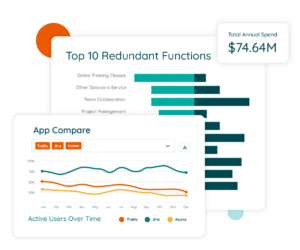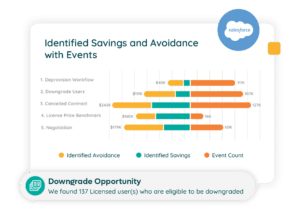Table of Contents
In many organizations (far too many), IT is viewed as little more than a cost center. How did it get a reputation as a department that eats budget while adding nominal value? Sure, cost centers can add profit indirectly. But this negative stigma around IT as a mere cost center prevents them from realizing their full potential.
Despite this perception of IT as the Pits of Angband, dragging your budget away never to be seen again, we believe IT can be much more than just a cost center. And we can prove it.
IT: Cost Center, or More?
Sure, people are happy to call IT helpful. But they’re much more reluctant to call it “valuable,” from a profitability perspective.
Let’s change the reputation of IT. Yes, it is a cost center by definition. But that can empower leaders to make IT a unique source of value for the organization.
With the emergence of SaaS management, the tangible impact and value of IT have increased greatly. That’s because IT is focused on optimizing the second largest operating expense for your organization: software.
It’s no surprise that rationalization is at the forefront of most CIOs’ minds for the coming year. Reducing your SaaS footprint is key to a more efficient software stack. Even greater, it allows you to funnel cost savings back to your bottom line. This is especially critical when responsible business growth is key to long-term success.
Most importantly, IT has the opportunity to get creative on how they deliver value to the organization.
Jason Owens, Senior Director of Global ITAM at Salesforce, explained, “No matter how much value we drive for our investment, we’re still a cost center. I don’t say that in a negative way. It’s a reality that we have to work within the framework and deliver value from within those barriers and boundaries. It gives us a really neat canvas to be creative on how we do that.”
IT is a cost center, and that’s ok! That doesn’t mean IT is inherently a money sink. The indirect value IT adds to an organization can be a game-changer.
“As a program, we pay for ourselves,” Owens said. “It’s one of the metrics I track, making sure not just that we’re cost neutral from a fully loaded salary perspective, but that we’re returning significant value.”
3 Ways IT Can Drive Business Value with SaaS
Drive Efficiency in Your SaaS Stack
Let’s embrace IT’s role as a cost center by focusing on its ability to provide value to your company’s growth and profitability. Through this lens, one critical goal of IT is to drive efficiency in your SaaS stack and across your business.
Push for optimization in your company’s software. We live by the rule, “Use what you pay for, pay for what you use.” Ensure efficient use of your applications and licenses. By optimizing your stack, you foster greater productivity, collaboration, and capacity for innovation across the business.
Let’s talk about how you can drive that optimization.
Reduce Your SaaS Footprint
 Most SaaS stacks are rife with redundancies and application bloat. When more employees are on fewer apps, it makes collaboration easier because apps are standardized across the organization. Plus, employees get time back when they aren’t jumping between a ton of tools all day.
Most SaaS stacks are rife with redundancies and application bloat. When more employees are on fewer apps, it makes collaboration easier because apps are standardized across the organization. Plus, employees get time back when they aren’t jumping between a ton of tools all day.
Not to mention, fewer applications to manage saves IT a ton of time. There are fewer systems to connect, which means fewer IT calls and problems. And, from a security perspective, fewer applications means fewer back doors for bad actors to enter.
Maximize Adoption and License Utilization
With a smaller SaaS footprint, your licenses also get consolidated. Fewer applications with more SaaS licenses may result in better adoption and utilization rates. Boosting both of these metrics is huge when it comes to efficiency. Not to mention, better utilization can help you negotiate better pricing with vendors on a per-license basis.
Ensure Data Governance
Finally, understand your organization’s data architecture and footprint, and know where your data is located. According to Steve Gentry, former CISO at Clari, this helps “drive better efficiency in the processes by getting people the access to the data they need, when they need it, wherever they need it.”
Power Savings to Reinvest in Innovation
If IT’s a cost center, reclaiming unnecessary or wasteful spending on software can impact your bottom line. Then, you can use those savings to reinvest in innovation and new projects that are transformative for your business.
 Here are a few ways you can reclaim savings on SaaS:
Here are a few ways you can reclaim savings on SaaS:
- Consolidate redundant applications. Canceling unnecessary applications and contracts leads to tangible cost savings.
- Maintain foundational license management practices. If you can reclaim unused licenses on an ongoing basis, you can prevent yourself from purchasing additional licenses and thus avoid new costs.
- Eliminate shelfware. Rightsizing your licenses at renewal may result in reduced contract fees, which is a great way to secure more savings.
Brad Pollard, former CIO at Tenable, uncovered massive underutilization with their voiceover IP tool, fueling the decision to move to Zoom Phone.
“We ended up saving a ton of money,” he shared on our podcast. “We ended up staying flat on budget, not losing any functionality, and then having money to do innovation, do new projects.”
Support a Better Employee Experience
Finally, there are few better ways to achieve indirect value than by empowering employees. As an IT leader, you are uniquely positioned to get employees the tools they need to do their jobs. Often, an enterprise software store with your catalog of approved applications makes this easy and frictionless.
Communication is critical here. To be effective, employees must know how to access and request said tools. They also need to understand the how and why behind your governance policies. As a result, employees will look to you as a trusted resource and partner within your organization.
IT can provide the best tools to the right people. “Because we sit in business technology, we get to focus on the enablement piece,” shared Owens.
“It’s like, how do we unlock value from our software for our people to go do their jobs, right? Because at the end of the day, that’s what this stuff all is: tools in the tool bag that individuals can use to deliver their value to the organization.”
Evolving Your SaaS Governance Framework for the Digital Workplace
Learn MoreSaaS Management Transforms IT from a Cost Center to a Value Driver
Efficiency, cost savings, and risk reduction can be achieved through SaaS management—all the things you want in IT. Yet, SaaS is an uncontrolled blindspot in spending; just 18% of apps fall under IT’s purview. Without a centralized SaaS inventory, your organization is likely to suffer from rampant inefficiencies and risk.
SaaS management helps you extract business value from your software investments. Chris Asing, Head of IT at Redis, shared his philosophy.
“Making sure that we’re compliant and we’re risk aware and we’re actually making decisions with a pretty consistent and systematic method for analysis and due diligence. I think that’s key. It has to be very clear, straightforward, and efficient.”
Learn the ins and outs of SaaS management and position IT as an effective value driver in your company.

